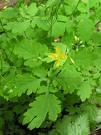Greater Celandine
Chelidonium majus Papaveraceae Colonising hedgerows, waste ground and damp areas such as ditches, the greater celandine bears small yellow flowers from April to July. The whole plant is covered in fine bristly hairs. If you snap the stalk or root it exudes dark orange sap. Medicinal usesIn traditional Asian medicine, greater celandine is used to calm the nervous system. The sap has long been a country remedy for wart removal. Today, the herb tends to be prescribed for liver problems. The herb's antispasmodic action can ease spasms in the upper digestive tract and other digestive disorders, and is also helpful in the treatment of coughs and asthma. Greater celandine acts against bacteria and viruses. And in 2002 Korean scientists reported that it may also be an anticancer agent. In vitro studies in Germany in 1996 suggest that greater celandine could have a role to play in treating illnesses of the nervous system. The plant has mild analgesic and sedative qualities and can be used to ease rheumatic pain. Parts used
ConstituentsThis plant's active compounds are alkaloids. The main one in the plant as a whole is protopine, an antispasmodic. The root also contains chelidonine, another antispasmodic alkaloid that also lowers blood pressure. In addition, greater celandine contains organic acids and carotenoids. PREPARATION AND DOSAGEFor internal use Greater celandine preparations should only be taken internally in consultation with a qualified medical herbalist For external use TO TREAT skins conditions such as warts, ringworm and eczema FRESH SAP Apply to the affected area one to three times a day. IF SYMPTOMS PERSIST CONSULT A DOCTOR CultivationGreater celandine likes moist soil and tolerates sun and shade. Do not plant in gardens used by children or cultivate for home use. CAUTIONS
|
Ayurveda Book
This book on Ayurveda is meant for people interested to know about basics concepts of Ayurvedic healing and learn ayurveda concepts. Though there are many books Read More My SitesReal Testimonials
Connect with us |







